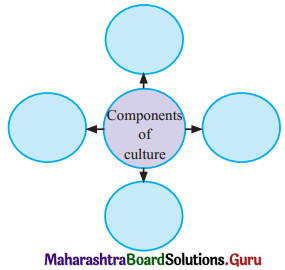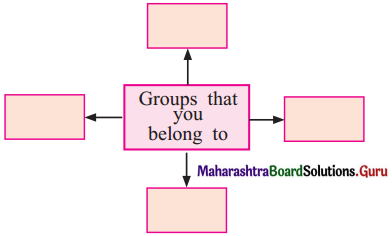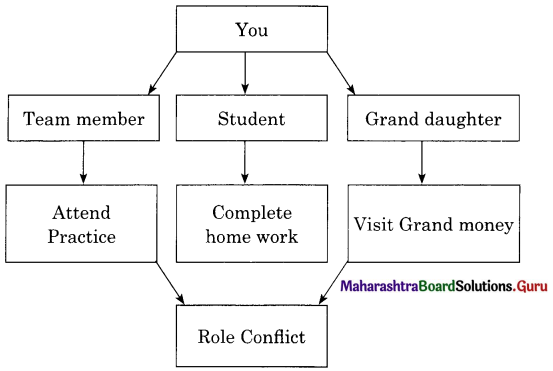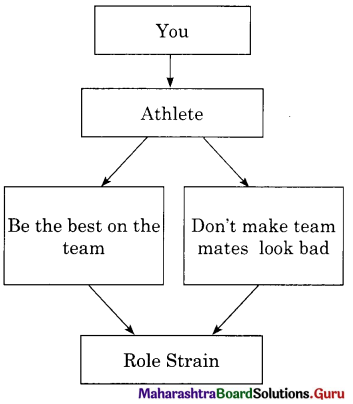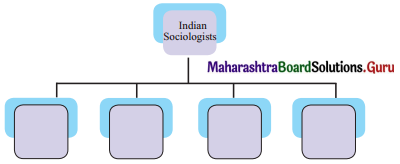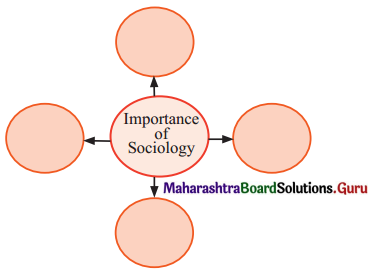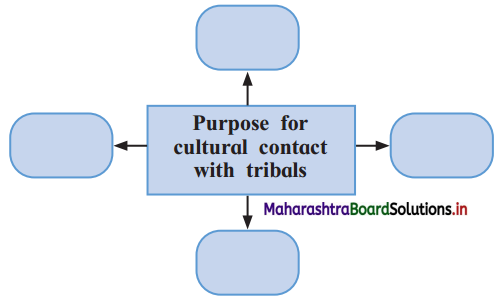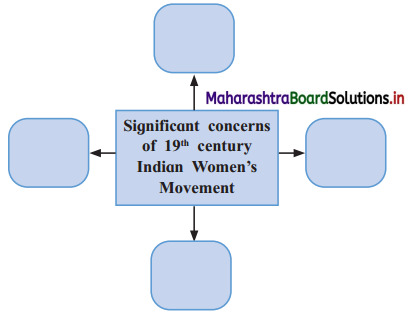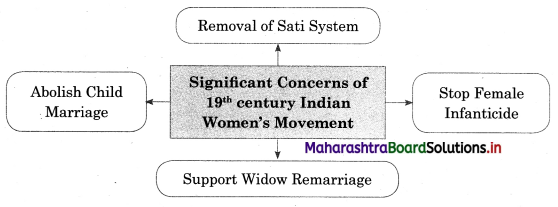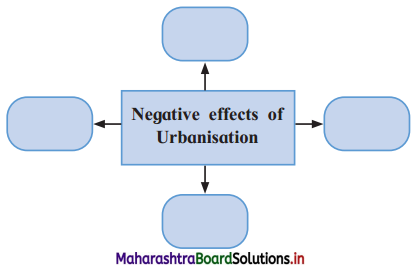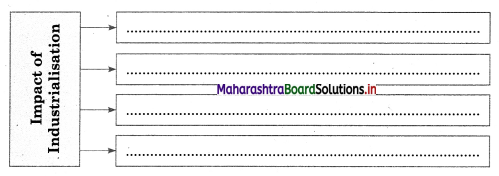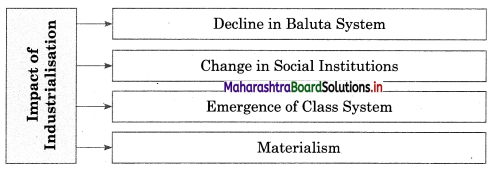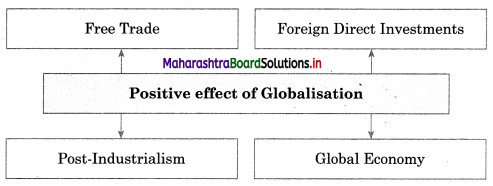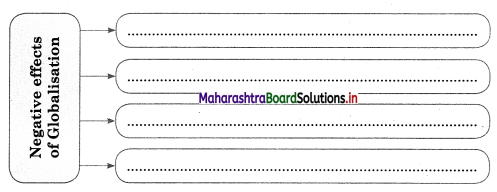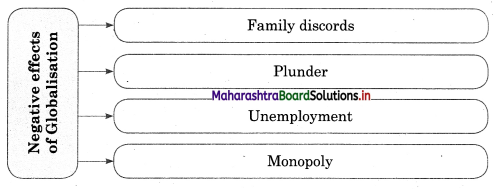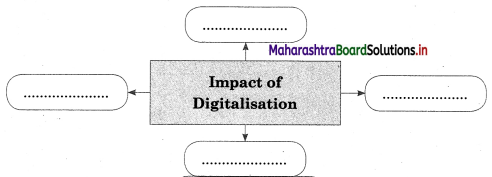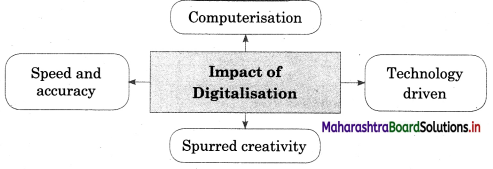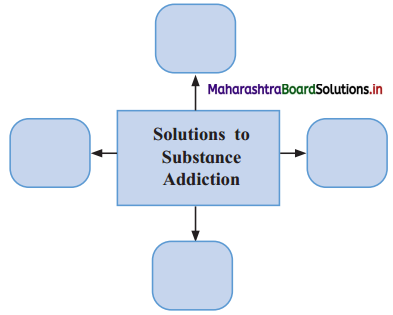Sociology Class 11 Chapter 6 Socialization Question Answers Maharashtra Board
Balbharti Maharashtra State Board Class 11 Sociology Solutions Chapter 6 Socialization Textbook Exercise Questions and Answers.
Socialization Class 11 Sociology Chapter 6 Questions and Answers
1. (A) Choose the correct alternative and complete the statements.
Question 1.
The process whereby an individual learns to conform to the norms of society is called …………………..
(assimilation / socialization / co-operation)
Answer:
socialization
Question 2.
Family is a ………………….. agency of socialization.
(primary / secondary / tertiary)
Answer:
primary
![]()
Question 3.
School is an ………………….. agency of socialization.
(primary / secondary / tertiary)
Answer:
secondary
Question 4.
Television is a / an ………………….. medium of communication.
(audio / visual / audio visual)
Answer:
audio-visual
1. (B) Correct the incorrect pair.
Question 1.
(a) Language, behaviour – Family
(b) Social values like friendship – Peer Group
(c) Teamwork, discipline – Neighbourhood
(d) To build opinion – Mass media
Answer:
(c) Team work, discipline – Workplace
1. (C) Identify the appropriate term from the given options.
(Internet, Peer Group, Childhood, Socialization)
Question 1.
Takes place in the early years of life.
Answer:
Socialization
Question 2.
Global impact in today’s world.
Answer:
Internet
![]()
1. (D) Correct the underlined words and complete the sentence.
Question 1.
Radio is an audiovisual medium.
Answer:
Radio is an audio medium.
Question 2.
Peer group is an example of an authoritarian agency.
Answer:
Family is an example of an authoritarian agency.
2. Write short notes.
Question 1.
Formation of ‘self ’ according to Mead.
Answer:
George Mead has elaborated on the process of building social self which does not exist at birth. According to Mead, formation of self occurs in three distinct stages.
Stage 1 – Imitation : In this stage, children imitate behaviour of adults without understanding it. Example : A little boy might drive his mother to her office by driving his toy car or help his parents clean the floor by pushing a broom.
Stage 2 – Play stage : A child plays, sometimes as being a mother or a teacher, at times a postal worker, a police officer etc. In this stage, responses are not organized. A child internalises the attitudes of others who are significant to her/his through enacting the roles of others. A significant other is someone whose opinions matter to us and who is in a position to influence our thinking.
Stage 3 – Game stage : As a child matures, and as the self gradually develops, one internalises the expectations of a large number of people. Children learn to behave according to the impressions of others. They understand that role play in each situation involves following a consistent set of rules and expectations. For example, a child at this stage is likely to be aware of the different responsibilities of people in a restaurant who together, make for a smooth dining experience. Thus, the self is mainly formed through our interactions with others and our understanding of others responses. Socialization, in this sense is a process of self-awareness.
Question 2.
Agencies of socialization.
Answer:
There are different social groups which can be seen as agencies of socialization.
1. Family : Family is the main agent of socialization. The child learns language and other basic behavioural patterns in family. Socialization through family is varied because there is no single, uniform pattern to do so. A child brought up in nuclear family will undergo different pattern of socialization. Patterns of child rearing vary across families with different caste, class, and ethnic backgrounds.
2. Peer groups : Peer groups are friendship groups made up of people of similar age. In peer groups, the interactions are reasonably egalitarian as there is a greater amount of give and take, when compared to family or school. Peer groups use informal sanctions including positive sanctions like approving gestures or laughing at your jokes, and negative sanctions like disapproving jokes, labelling or rejecting your company.
3. Schools : Schooling and education are considered as secondary agencies. School involves learning values and norms at a step higher than those learnt in a family. Skills and values like team work, discipline, conformity to authority are learnt in schools and this helps prepare students for the adult world.
4. Mass Media : One of the significant forces of socialization in modern culture is mass media. Mass media are the means for delivering impersonal communication directed to a vast audience. Mass media includes traditional print media like newspapers and magazines, electronic media like radio and television and current IT enabled media and social media. Television has an influence on children from a very young age and affects their cognitive and social development. Modern technological advancements have strengthened and changed the role of mass media. Technology has certainly increased the spread of mass media.
5. Neighbourhood : A neighbourhood community is an important agency of socialization. A neighbourhood is a geographically localized community within a larger city, town or suburb. Neighbourhoods are formed through considerable face to face interaction among members often living near one another. A neighbourhood community provides the base for an individual to extend social relations and interactions beyond the narrow limits of the home.
6. Workplace : Socialization is a life long process. Adult socialization indicates this continuous process of learning. One of the significant agents of adult socialization is the workplace.
Adult individuals spend significant amount of time at the workplace. Socialization through work place involves acquiring new skills, knowledge and behaviour patterns suitable to the requirements of the job.
![]()
Question 3.
Resocialization.
Answer:
The process of unlearning old norms, roles, values and behavioural patterns and learning new patterns is called re-socialization. Sometimes an individual is caught in a situation where one has to break away from past experience and internalise different norms and values. Re-socialization can also be defined as a process which subjects an individual to new values, attitudes and skills according to the norms of a particular institution and the person has to completely re-engineer one’s sense of social values and norms.
The person may be in a jail, hospital, in religious organization, police, army etc. In such institutions there is total break up from the normal social life outside. A prison sentence is a good example. The individual not only has to change and rehabilitate one’s behaviour in order to return to society but must also accommodate the new norms required for living, while in prison.
3. Explain the following concept with an example.
Question 1.
Primary socialization
Answer:
- The most critical process of socialization happens in the early years.
- This learning in the early years is termed as primary socialization.
- Primary socialization takes place in infancy and childhood and involves intense cultural learning.
- A child gets acquainted with values, customs, behavioural norms and manners. It is an informal process.
Example : Family is the main agent of primary socialization. Peer group and neighbourhood is also seen as a primary socializing agency.
Question 2.
Secondary socialization
Answer:
- Socialization as a process is lifelong.
- The learning which extends over the entire life of a person is known as secondary socialization. It is a formal process of socialization.
Example : Schooling and education are considered as secondary agencies of socialization. What we learn through a formal curriculum with specific subjects and skills. Schooling involves learning values and norms at a step higher than those learnt in family.
4. (A) Complete the concept maps.
Question 1.
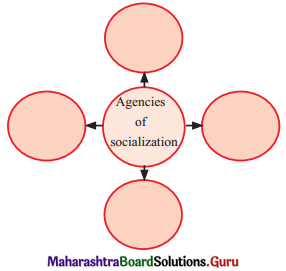
Answer:

![]()
4. (B) State whether the following statements are true or false with reasons.
Question 1.
Socialization is a life-long process.
Answer:
This statement is True.
(i) The process of learning attitudes, norms and behaviour patterns and becoming members of different social groups like family, kin network, peer group and later, formal groups like school, professional networks etc., is a life long process.
(ii) Socialization is an ongoing process of continuous learning The birth of a child is a new experience of parenting for a couple. Similarly, older people become grandparents thus creating another set of relationships connecting different generations with each other.
(iii) Thus, socialization as a learning process is life long even though the most critical process happens in the early years but secondary socialization extends over the entire life of a person.
Question 2.
Advertisements influence consumer behaviour.
Answer:
This statement is True.
- Mass media has become an integral part of our day to day life. Advertisements through mass media are the means for delivering impersonal communication directed to a vast audience.
- Advertisements transmit information and messages which influence the behaviour of the consumer to a great extent.
- The use of colours, words, music, images, videos influence our behaviour and persuades us to take action. Advertisements through mass media has wider approach.
5. Give your personal response.
Question 1.
‘Breaking News’ tends to create panic or emotional responses. Why do you think this happens? Give relevant examples to illustrate.
Answer:
Many newspapers as well as some private news channels very frequently transmit news of murders, accidents, stealing, dacoity, beating, rape, economic cheating, fraud, scams, etc., as breaking news. Constant hearing of such news affects the minds of the people and it weakens the faith in ideals and values of life. This happens because breaking news get much more viewers than normal news.
Question 2.
The use of ‘unacceptable language’ is often picked up by children even if this kind of language is not used within the home. Explain how this might happen.
Answer:
Even though the new born is initiated with this learning process in family it is not the only agency of socialization. School, peer groups, neighbourhood, mass media are different social groups and social contexts which can be seen as agencies of socialization. Children pick up unacceptable language from variety of other sources like television which has strong influence on viewers. The child might hear one of his friends or someone in neighbourhood using slang words or abusing language.
![]()
6. Answer the following question in detail (About 150-200 words).
Question 1.
You belong to a generation that has been exposed to internet. Discuss how internet has brought about positive and negative results.
Answer:
Modern technological advancements have strengthened and changed the role of mass media as an agent of socialization. Technology like internet has certainly increased the spread of mass media. People spend most of their time in touch with the world. Internet has enhanced communication and social connection. It has also increased political and civic participations. Social media allow students to learn outside of their class rooms. ‘School in the cloud’ is yet another example of how the internet and social media can help to improve global education.
Internet has helped to transmit information and create awareness about a wide range of issues and events among members of the society. It influences attitudes, values and moulds public opinion and acts as an effective way to change the society. Through the internet we can access online educational courses or training. In fact, any type of information from any part of the world can be accessed through the internet.
There is also negative impact of internet on society as – Youth access the internet and indulge in chatting, emailing, watching restricted site that leads to cyber crimes instead of creating interest in reading and creative activities. Sometimes internet may not give accurate information hence the validity and accuracy of the messages must be considered. Internet reaches the masses in developing countries, but there are many tribal, rural and poor urban people having no access to any kind of information. Communication technologies are expensive and need maintenance. Thus, internet may help to develop knowledge and spread information but it also has adverse effects on the society and have promoted values like individualism and materialism.
11th Sociology Digest Chapter 6 Socialization Intext Questions and Answers
ACTIVITY (Textbook Page No. 68)
Question 1.
Conduct a group discussion on the threatening challenge of online games like ‘Blue Whale’. Try to find answers to issues like why do children even consider participating in such games? Are parents to be blamed? What is the role of Law?
Answer:
Games like ‘Blue Whale’ has the challenges of self-harm. It exploits vulnerable people. It blocks the boundary between virtual and real world. There’s a constant competition, level up, which drive the children to perform their best amongst others.
Most games are addictive become of the challenges involved. Once the children are engrossed in it, there is no coming back and they strive hard to achieve the next level, the next goal. This sense of achievement targets the brain’s reward system and compels the gamer to perform the act again and again.
Are parents to be blamed?
Children are becoming addictive to online games because they are designed to be addictive and not because parents allow them to play too much.
What is the role of Law?
With dangerous online games like ‘Blue Whale’ claiming several innocent lives in the recent past, the supreme court has directed the centre to constitute a panel of experts to block such life-threatening games.
![]()
Question 2.
Watch advertisements or messages on T.V. and see how effective mass media is in creating awareness against corruption, drug addiction, smoking or any other relevant social issue. (Textbook Page No. 68)
Answer:
The mass media has potential to create awareness against various issues like corruption, drug addiction, smoking etc., by propagandise simple and focused messages to large audiences repeatedly, overtime, at a low cost. They are able to reach a large heterogeneous population. Media campaigns can help in the reduction of smoking and drug addiction and have shown positive results in number of other relevant social areas. Techniques of mass media can be effectively used to counter corruption as well.
Question 3.
Do you think resocialization requires total institutions? Why? Why not? (Textbook Page No. 70)
Answer:
In the process of resocialization old behaviours are removed because they are of no use. Resocialization is necessary when a person moves to a senior care centre, goes to a boarding school or serves time in jail. I think, resocialization requires ‘total institutions’ in a new environment as they can learn new norms and unlearn existing behaviours. The most common way of resocialization occurs in a total institution where people are isolated from society and made to follow new rules and behaviours. A ship at sea military camps, religious convents, prisons or some cult organizations. They are cut off from a larger society. Members entering an institution have to leave behind their old identify to be socialized.
Question 4.
Collect data from five students regarding their experience with social networking sites (example Facebook, Snapchat, Twitter). Find out about how much time they spend online, what kinds of people they interact with, what topics are usually discussed, the uses and problems of social networking sites. Write a 100-word Report on your findings. (Textbook Page No. 71)
Answer:
With respect to overall media consumption, most students spend hours on social networking sites using mobile phones, tablets, laptops, desktops, etc. This age group restricts watching television and is considered as the largest part of change in the media landscape. Example: More three to eleven years of age group are online than in 2016, with much of this growth coming from increased use of tablets. Unsurprisingly, tablets and other portable, connected devices are also playing an important role.
![]()
Uses:
Social networking sites allow users living at distant places within their network to connect to another thus increasing social connection, share ideas, photographs, videos, information and other happenings around the world.
Problem:
- Untrustworthy Member Data.
- Users submit inaccurate information on their profile.
- Leaving social networking is difficult; there are saved accounts, and ways to continue to reconnect to the site, even after an individual uninstall the account.
- Less time for face to face connections with family members.
- Being too much online diminishes our skills and can have serious side effects. These side effects are becoming more and more frequent amongst the waves of generations.
Class 11 Sociology Textbook Solutions Digest
- Sociology Class 11 Chapter 1 Question Answers
- Sociology Class 11 Chapter 2 Question Answers
- Sociology Class 11 Chapter 3 Question Answers
- Sociology Class 11 Chapter 4 Question Answers
- Sociology Class 11 Chapter 5 Question Answers
- Sociology Class 11 Chapter 6 Question Answers
- Sociology Class 11 Chapter 7 Question Answers
- Sociology Class 11 Chapter 8 Question Answers
